Christmas is that time of the year that smells different because foods tend to be different at this time.Romeritos in Mexico, Viteltoné in Argentina, Ham bread in Venezuela, are some of the examples of the typical dishes for the end of the year parties.The options are varied and delicious, but alsothere are many coincidences, as we suspected: pork and tamales abound on the menus.But why do we eat what we eat at Christmas? Where does this tradition come from?
We asked four gastronomic historians of the region:
Mexico and its diversity
Romeritos, pozole, turkey, pork, tamales, cod … and don’t forget the tequila punch and the apple salad.The evidence shows that it is very assorted and varies according to the sector of the country we are talking about.However, two meals are repeated in almost all the territory: turkey and pork, especially the marinated and stuffed leg.
There are the romeritos, which belong to the group of quelites, which translated into Spanish would be edible herb and should not be confused with the rosemary seasoning. The dish is a casserole that contains romeritos, mole and shrimp powder.

“Apparently romeritos have been eaten since pre-Hispanic times,” says Yolanda García González, a doctor in History and specialist in food from the 16th and 17th centuries in Mexico.
In the center of the country, cod a la Biscayne is also eaten, although with a Mexican intervention.“It is Mexicanized Biscay cod. The vizcaíno is only tomato puree and perhaps a bell pepper. And here, we add potatoes, olives, capers, almonds, also depending on the region where we prepare it,”García González says.
And why cod?
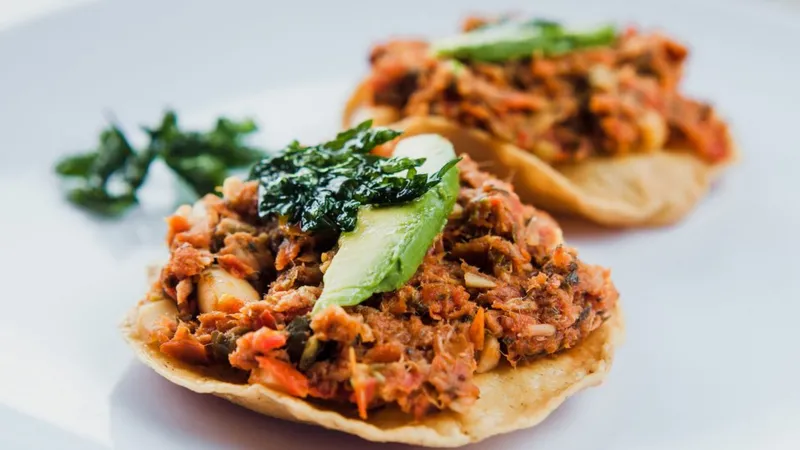
“That food enters through the gulf, through Veracruz, which is where the shipment of cod arrives and is distributed throughout the territory. In the bars and cantinas of Mexico City it is typical to find cod cakes at this time. It’s a holiday meal ”, he details.
The historian explains that the Christmas menu in Mexico is deeply linked with the arrival of Spanish customs, and especially with what religion dictated about what you could eat or not.
“Products such as pork legs, cow quarters are found in the expense books of 16th century convents, particularly for the December festivities,” says García González, who is the director of Cocina, a website that addresses the origin of the Mexican cuisine from history, art and science.
The Central American and Caribbean menu
“Tamales and baked pork are not lacking in Honduras,” wrote a reader on Instagram. “Pan with turkey in El Salvador”, published another. “In Costa Rica, pork chops and tamales,” said a third. The central area of Mexico is where the Christmas menu seems to be more extensive.
With nuances in each one, the ingredients of the Christmas menu in Guatemala, Honduras, El Salvador, Nicaragua, Costa Rica, Panama, Cuba, the Dominican Republic and Puerto Rico tend to coincide.

“The dishes are repeated because the ingredients are the same. What changes is the way of making them and the names according to the indigenous cultures, their language and those who populated after the conquest, as is the case in Africa”, explains Cruz Miguel Ortiz Cuadra, Puerto Rican historian and author of several books and essays on the history of food in the Caribbean.
Among those common ingredients are banana, rice, and pork
Ortiz Cuadra confirms the fact that pork predominates in the Christmas menu of Latin American countries thanks to the Spanish. And precisely the first to arrive: Christopher Columbus.
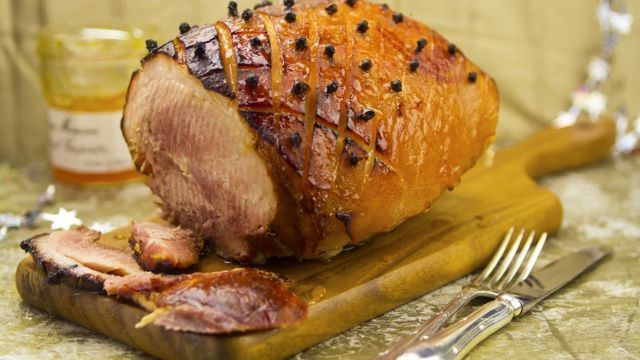
“The first pigs were brought by Christopher Columbus in 1493, on his second voyage. It brings them from the island of La Gomera in the Canary Islands. Strategically bring in eight pregnant sows. That was a tactic of the conquering Europeans to reproduce the animals once they got here”, details Ortiz Cuadra, who is a professor at the University of Puerto Rico.
For the Spanish of that time, the pig was very significant because in their vision its consumption stimulated the blood and had a great nutritional value.But it was also a religious symbol: whoever ate pork was a Christian and differed from Muslims and Jews who were heavily persecuted at that time.
The animal begins to reproduce in the Caribbean very easily
“The pig moves throughout the Caribbean and they are established and very fixed Christmas dishes,” Ortiz explains.Although the pig began to dominate the menu, an animal was not slaughtered every day. Eating a whole pig was for special dates, like Christmas.
The historian says that it is probable that from this time the saying “they have it as a piglet for Christmas” arises, which means that they are raising and fattening the pig to slaughter it.
Another ingredient that cannot be missing from the Caribbean Christmas menu is rice
“I call them compound rice because they have several ingredients that vary according to the country,” says Ortiz Cuadra.”At Christmas dinner in Puerto Rico there will always be rice with pigeon peas and pork,” he says.
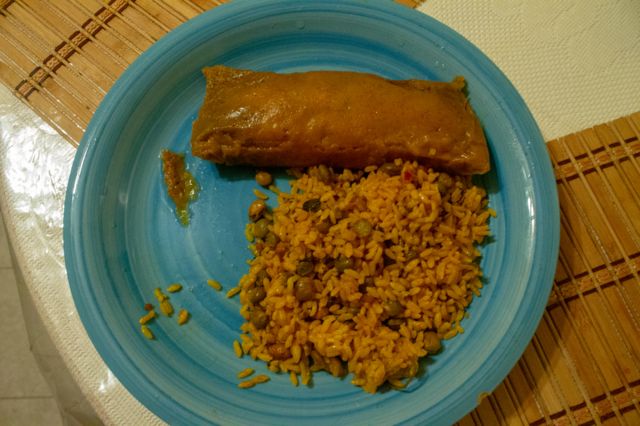
Curiously, the pigeon peas are a legume native to India that reached Africa through the Portuguese trade in the 16th century and later moved to America by slaves.And rice appears in the Caribbean by the Spanish, and in turn reaches the Iberian Peninsula through the Arabs. This dish is also eaten during Christmas in Panama.
Hallacas, tortillas and tamales
A typical Christmas dish that Venezuelan`s highlight is the Hallacas. It is a cornmeal dough seasoned with chicken broth and colored with achiote. It can be filled with beef, pork or chicken. All this wrapped in a banana leaf.
According to Professor Ortiz Cuadra, this dish is also found in Puerto Rico and the Dominican Republic, but with another name and variations in the ingredients.In the Dominican case they are called tortillas also in Puerto Rico.
And also in the Christmas menu of many countries in the region are tamales. “The tamales wrapped in corn husks are originally from Mesoamerica. But the indigenous people of the Caribbean also used ground corn to wrap and boil it, as in Puerto Rico called guanimes”, Ortiz Cuadra details.
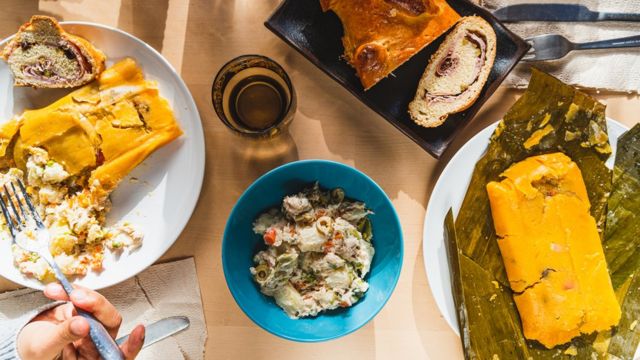
And some countries even have tamales with their own name, such as the Nicaraguan nacatamales, which can be made with meat, vegetables and rice wrapped in banana leaves.
Another dish that cannot be missed on the Venezuelan table is ham bread
As its name says, it is a bread with ham, smoked bacon, raisins and green olives. According to the Venezuelan gastronomic journalist Miro Popié, the recipe was invented in 1905 in a bakery in Caracas and its acceptance was immediate.
Colombian delicacies
Colombians listed natilla, hojuelas or hojaldras (a fried dough sprinkled with sugar or lemon) and rice pudding. “The typical dishes of Colombia are mestizo products,” says Cecilia Restrepo, a researcher at the Colombian Academy of Gastronomy.
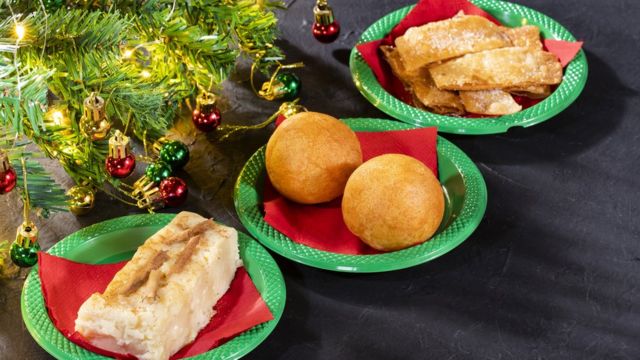
And the Colombian buñuelos are a clear example of this since it is a corn dough – an ingredient originating in America – with the cheese that was brought by the Spanish and then sugar syrup is added.
According to the specialist in food history, in most cases, the origin of the dishes are not counted in the historical documents
“But there are many Spanish foods that have Arab influence and that arrived here, such as buñuelos or almojábanas,” which is a sweet roll.Restrepo also mentions another very important Christmas sweet that is consumed in Popayán, in the Valle del Cauca, which is called desmargado and is prepared with lemon peels and syrup.
And on the salty side, on the Colombian Christmas table there are tamales -with different ingredients depending on the region-, ajiaco -a stew made with meat, potatoes, chili peppers, onions and legumes- and empanadas.
Bittersweet dishes
Christmas in Peru usually includes turkey, pork, tamales and panettone, that famous sweet bread filled with raisins and candied fruits, although there are versions with chocolate.The latter is also very common in Ecuador. There they also told us about the pristiños, “a dough that is fried and put on a panela honey.”
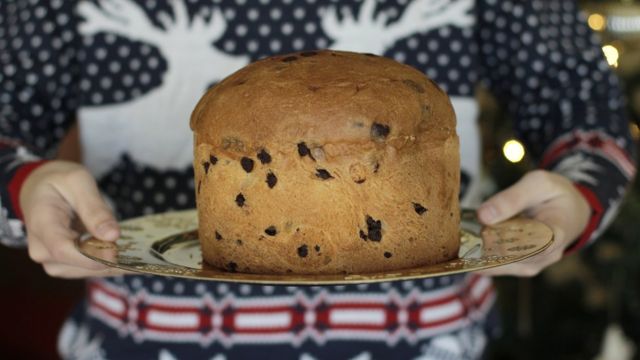
In Paraguay, pork is repeated as the star menu of Christmas, accompanied by Paraguayan soup or a chipá and with a very cold cider. And in Bolivia you eat picaña, suckling pig, turkey and fritters with a cup of chocolate.
In the Southern Cone, Christmas menus are made up of roast meats and sweet and sour dishes
Asado for any type of celebration is what is eaten the most in Chile. “Monkey tail”, an alcoholic drink made with milk, pisco or brandy is also popular.
In Argentina and Uruguay there is also the viteltoné, beef covered with a fish sauce
“Viteltoné is as we call it in the Río de La Plata, but it is vitello tonnato in Italian. Vitello is cow and Tonnato is ‘tuna’. And obviously it comes from Italian immigration” details the Uruguayan anthropologist specialized in food Gustavo Laborde.“It is the only dish in which the Creoles of the south allow themselves to mix beef and fish. On no other occasion would we accept to eat that mixture”, he analyzes.
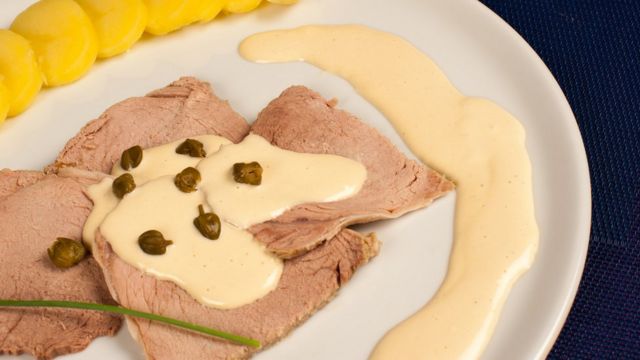
Suckling pig accompanied by Russian salad also appears on the menu of southern countries, which contains potatoes, carrots and peas, all mixed with mayonnaise. There is also a tradition of eating roast lamb.
But Laborde says that bittersweet combinations stand out at the end of the year parties, such as the carré of pork accompanied by an apple puree, or a starter of raw ham with melon.
“Ham with melon is a dish of medieval origin and it was a medical prescription. The dietetics of the time were dominated by the theory of humors and they understood that the fruit decomposed rapidly in the body, so to balance it, you had to add something dry and cold, which was ham”, describes Laborde.
But all the specialists agree on one thing: there is a lot of food on the Christmas menu
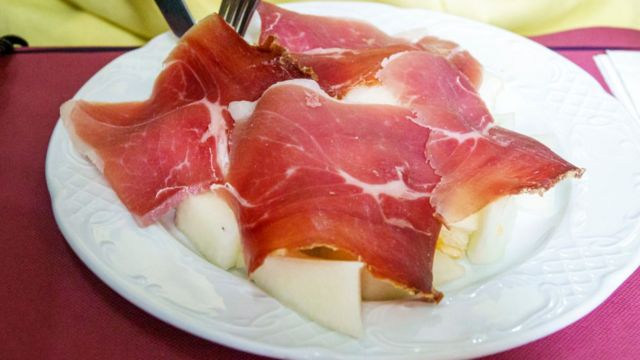
“Abundance is prosperity. It is spent to eat rich and that the whole year can be received ”, assures the Mexican historian Yolanda García González.“The Christmas parties are particular from the anthropological point of view because elements of the past emerge. Both champagne and sugar, which were luxury products in ancient times, are still associated with these celebrations”, analyzes the anthropologist Laborde.”Perhaps there are not so many sophisticated preparations but they are abundant,” she adds.


